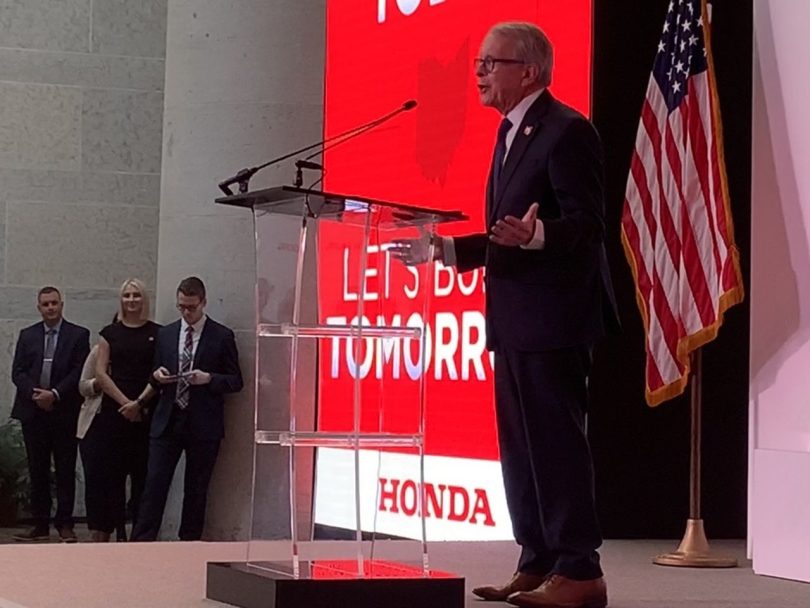[ad_1]
MARIETTA, Ohio — As Ohio grows into a manufacturing hub for electric cars and lithium-ion batteries that make the vehicles run, automakers will need a secure supply of raw materials to keep assembly lines moving. For that to happen, however, minerals and metals for batteries to be built at the planned Honda plant and other factories will need to be mined and processed primarily in the United States instead of imported from China and Russia.
Right now, there are lots of questions about the supply chains for battery metals like lithium, cobalt, nickel and copper. China, the world’s leading electric-car manufacturer, has a tight grip on the global supply of battery metals, something that drew shudders earlier this year during the confrontation over Taiwan and a few years earlier during tense trade negotiations with China. U.S. automakers have every reason to fear that China might use battery metals as a geopolitical weapon to get the upper hand in world markets.
As OPEC once again tightens the screws on U.S. energy consumers, cutting production to raise oil prices, there’s a sense that the geopolitics of the metals trade needed for the energy transition might be just as unpredictable as our dependence on the global oil cartel.
Now is the time to ask: What are the most useful things the U.S. government can do to strengthen our mineral and metals supply chains? Do we continue to rely on belligerent countries like China and Russia for materials needed for clean energy technologies, weapons systems and consumer products? Or do we make greater use of our own abundant resources in the United States?
The obvious answer is that we must start producing more, not only to shore up our supply-chain security but also to help our economy create thousands of well-paying mining and manufacturing jobs, bring millions of dollars to federal and state treasuries, reduce carbon emissions and enable America to become less dependent on China and Russia.
The International Energy Agency (IEA) says in a report that production of battery metals and minerals needs “to expand ten-fold to meet projected critical mineral needs by 2030,” according to a recent article on mining.com. This will require the development of hundreds of new mines.
Presently, there is only one operating lithium mine in the United States. One nickel mine, one rare earth mine, one cobalt mine. And many copper mines have been depleted and are running out of resources, according to the U.S. Geological Survey.
The sticker shock for lithium has already arrived. Fueled by explosive growth of electric vehicles, particularly in China, the global price of lithium has jumped 678% in the past two years — and is likely to accelerate as the transition to electrified transportation progresses. The IEA expects demand for lithium to grow by as much as 40 times over 2020 levels, requiring the addition of 50 new lithium mines worldwide. But new mines aren’t opening fast enough, and auto industry experts warn that a shortage of lithium could derail electric-vehicle (EV) production just as it’s beginning to take off.
This realization convinced the White House that government action was necessary. Earlier this year, President Joe Biden invoked the Defense Production Act to provide loan guarantees, tax breaks and other federal assistance for the creation of new domestic mines for battery metals. The Inflation Reduction Act offers buyers of EVs a $7,500 tax break if portions of the car’s “critical battery materials [are] extracted or processed in the United States,” utilitydive.com reports.
But building a secure supply chain doesn’t happen overnight. The United States “has untapped mineral resources worth an estimated $6.2 trillion,” according to Value Walk Premium, but it’s been easier to import raw materials — even critically important battery metals — than to create new mines in this country. Just obtaining a government permit to open a mine in the United States takes as long as ten years or more — and there are so many hurdles that companies frequently fail to get approval and wind up developing new mines in other countries instead.

Robert W. Chase led the department of petroleum engineering and geology at Marietta College until 2015.
Congress needs to streamline our government’s mine-permitting process. A bipartisan effort to eliminate red tape in permitting for infrastructure improvements — not only mines but also for liquefied natural gas facilities and oil and gas pipelines — is percolating in the Senate. Passage of the measure would make supply chains much more secure.
A lot is riding on the production of electric cars, SUVs, pickups and trucks. Millions of vehicles will be sold in the next few years, and many will be built with batteries produced in Ohio. It’s about time that we begin making better use of the mineral riches in our nation’s own backyard.
Robert W. Chase served as chair of the Petroleum Engineering and Geology Department at Marietta College for 37 years and retired from that position in 2015. He is a registered professional engineer in the state of Ohio.
Have something to say about this topic?
* Send a letter to the editor, which will be considered for print publication.
* Email general questions about our editorial board or comments or corrections on this opinion column to Elizabeth Sullivan, director of opinion, at esullivan@cleveland.com.
[ad_2]
Source link








